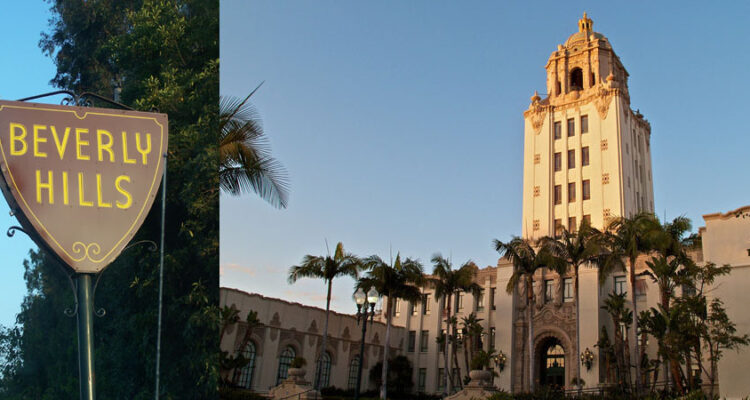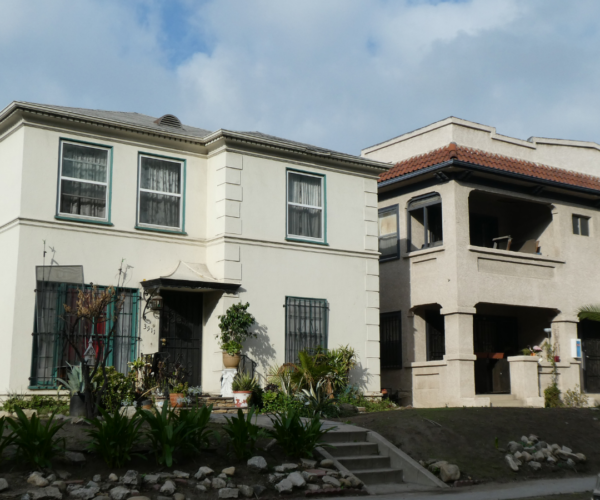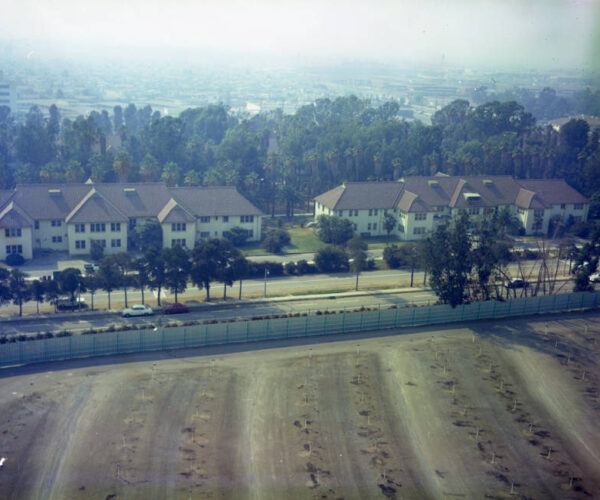
Lost
2015 Beverly Hills Historic Preservation Ordinance Amendments
A revised Historic Preservation Ordinance reflects a big step backward for historic preservation in Beverly Hills.
Lost
Historic places that have been demolished or irreparably altered.
Issue Details
Development Approval Process
Overview
On July 21, 2015, the Beverly Hills City Council made an amended Historic Preservation Ordinance official, through a 3-1 vote, representing a significant backslide in the City’s preservation efforts. This followed lengthy deliberations and discussions at a June 16 hearing that concluded with an initial 3-2 vote by the City Council to approve the revised ordinance.
Once fully implemented, the ordinance will undo much of the great progress that earned the City a grade of A+ on our Preservation Report Card. We are now revising the City’s grade in light of the ordinance changes.
On January 15, 2015, a Liaison Committee consisting of representatives from the Beverly Hills City Council, Planning Commission, and Cultural Heritage Commission rejected proposed, far-reaching revisions to the City’s Cultural Heritage Ordinance. Mayor Lili Bosse and Councilmember John Mirisch directed the two commissions to find consensus in a revised draft and to work with the Conservancy to ensure that the City’s A+ grade is maintained.
The Conservancy worked closely with City leaders in recent months to advise on the ordinance revisions, and we appreciate being part of the process. Unfortunately, the result is not good preservation.
The massive changes to the ordinance will have a chilling effect on local preservation and run counter to Beverly Hills’ commitment to protecting its architectural and cultural heritage. We strongly believe that this is a step backward and, by design, will severely limit preservation in the city.
Accordingly, the Conservancy urged the City of Beverly Hills to consider alternatives, including our suggestions (see “Our Position” tab) and recommended against adopting the proposed revisions to the ordinance.
Over the past few years, the Conservancy has worked closely with Beverly Hills. We provided technical assistance in the City’s creation and adoption of an innovative historic preservation ordinance in 2012. The ordinance earned the City the grade of A+ on the Conservancy’s 2014 Preservation Report Card for Los Angeles County.
The 2012 ordinance was based on widely-accepted models, including landmark designation criteria based on those for the California Register of Historical Resources, yet tailored specifically for Beverly Hills.
The revisions fundamentally seek to restrict both the quantity and type of resources able to be protected. They insert subjective designation criteria and policies aimed at preventing all but the most exceptional properties from attaining protection through landmark designation.
The revised ordinance will also severely restrict the City’s ability to protect potential historic resources that may be threatened, effectively limiting the ordinance as a preservation-planning tool.
About This Issue
In 2008, Beverly Hills had a very weak historic preservation ordinance that offered honorary landmark status and no true protections. It had never even been used to landmark any structures. The City had updated a 2006 survey of its commercial area, but the existing citywide survey from 1986 was over twenty years old and sorely out of date.
Sometimes, the threats to a specific historic building—in this case, the Kronish House and the efforts to save it—galvanize support that leads to something much bigger.
Beverly Hills is a good example. In the wake of some high-profile demolitions throughout the 2000s, the City catapulted ahead with a strong and active historic preservation program.
Beverly Hills adopted an innovative and strong historic preservation ordinance in 2012 and has implemented the Mills Act program, a powerful preservation incentive. The City also hired a dedicated historic preservation planner and created a Cultural Heritage Commission.
In recognition of these efforts, the Conservancy awarded the City of Beverly Hills and its preservation program an A+ grade in the 2014 edition of our Preservation Report Card. This grade reflected significant progress and major improvement over the city’s previous D score in the 2008 Preservation Report Card.
Since late 2013, efforts have been underway to review and suggest amendments to the Beverly Hills Historic Preservation Ordinance, led by members of the City’s Planning Commission.
In October 2014, the Planning Commission reviewed a series of changes that resulted in a red-line version and, ultimately, a revised draft “Preservation Ordinance.” The latest draft focuses on tightening landmark criteria and addressing issues including private property rights and reevaluating the pros and cons of local historic districts. Concerns were raised by the public and the Conservancy.
In November 2014, the Cultural Heritage Commission reviewed and commented on the draft Preservation Ordinance, also citing various concerns and a belief by some members that the amendments would compromise preservation efforts in the city going forward. One member stated, “…this new Ordinance was headed in the wrong direction.” Another commissioner cited the need to balance needed amendments while retaining the “meaningful ability to protect and honor the city’s heritage.”
The Conservancy shares these concerns regarding the latest extensive revisions to Beverly Hills’ Historic Preservation Ordinance, which greatly compromise the ability of the city to protect its historic landmarks and districts.
Our Position
Adopted changes to the Historic Preservation Ordinance can be found in the December 11, 2014, Planning Commission Report. Below, the Conservancy outlines some of our specific concerns, along with suggestions cited at the time:
10-3-3212: Landmark Designation Criteria
The landmark designation criteria have been changed from a set primarily based on those found in the California Register into a two-tiered set, with unconsented nominations required to meet additional criteria. A review of the proposed criteria demonstrates the high threshold needed to attain landmark status.
The subjective landmark designation criteria include:
- It is at least forty-five (45) years of age, or is a property of extraordinary significance
- It is a remarkable example of a single, specific architectural style, type, or period
- It is an exceptional work by a master architect:
- It is an iconic property
- It was owned and occupied by a person of great importance for a period of at least ten (10) years, and was directly connected to a momentous event in the person’s endeavors or the history of the nation. For purposes of this paragraph, personal events such as birth, death, marriage, social interaction, and the like shall not be deemed to be momentous.
To retain the integrity of the Historic Preservation ordinance’s landmark designation criteria, the Conservancy recommends against adopting those proposed by the Planning Commission. The proposed criteria are so restrictive that they may create the unintentional effect of preventing a California Register-eligible structure in the city from attaining local landmark status.
Of greatest concern will be the large number of historically significant structures throughout the city that will be denied the protection afforded by landmark designation because they are unable to meet the highly specific and subjective designation criteria.
10-3-3213: Historic District Designation Criteria
The historic district designation criteria have been changed to prohibit the designation of historic districts in an area of the city zoned for single-family development, including but not limited to those areas zoned R-1. Another proposed criterion stipulates that all of the contributing properties predominantly embody the distinctive characteristics of a single architectural style, type, or period.
The introduction of restrictive criteria such as these would essentially curtail most, if not all, potential historic districts from being designated. Most local historic districts comprise primarily single-family residential structures.
Additionally, it is common for designated historic districts to feature a variety of architectural styles, though they may relate to one another through the cohesive development pattern of the neighborhood and other shared physical characteristics including similar scale, massing, and setbacks.
Other cities have established relevant models for historic district designation criteria and designation that do not discourage the formation of local historic districts, such as those in Glendale and Burbank. Both cities require a two-step process for the formation of local historic districts. District proponents distribute petitions through the neighborhood, with the first petition asking the City to conduct a historic resource survey requiring at least twenty-five percent property owner support, and the second petition asking the City to implement the historic district requiring at least fifty percent property owner support.
This alternative model has proven to be successful. Since 2008, Glendale has successfully designated five local historic districts, with two additional districts currently pending.
10-3-3215: Landmark or Historic District Designation Proceeding
Many of the proposed changes to this section of the historic preservation ordinance set higher thresholds aimed at making historic resource designation more difficult to achieve. These changes would compromise the City’s ability to designate many architecturally and culturally significant structures.
Subsection A.1: When the application is by owners of contributing properties for designation of a historic district, it shall include a petition in support of the application signed by more than fifty percent (50%) of the property owners of legal lots within the proposed district, and shall also include a current list of names and legal mailing addresses of all property owners in the proposed district.
The Conservancy suggests that a demonstration of property owner support be part of the application review process and not tied to the application submission. Typically, a demonstration of property owner support for a proposed historic district is not required as part of the application process, but is instead submitted during the approval process, which allows applicants time to build support through various methods of outreach while the application is being considered for its architectural and cultural merits.
Subsection A.2.a: This “eligibility requirement” limits the possible structures that can be initiated for landmark designation by the Cultural Heritage Commission or City Council to those that appear in the Inventory or were designed by a person identified on the master architect list.
The Conservancy suggests that this language not be adopted, as it unnecessarily limits the actions of the Cultural Heritage Commission or City Council in initiating a landmark nomination. Such initiations typically take place when the City feels that a particularly significant property might be threatened, and the its ability to protect its architectural or cultural heritage should not be limited in this way.
Subsection A.2.d.3: This subsection limits to four the number of structures the Cultural Heritage Commission can initiate for designation in one year.
The Conservancy suggests that this proposed cap not be adopted. Because the City’s historic preservation program is still young, we recommend more time to evaluate the policy surrounding City-initiated designations to determine what the average quantity may be. This is the City’s tool for protecting potentially threatened resources, and the City cannot predict at what point in any given year that such a situation may arise.
Subsection F (original): The “Interim Protection Measures” subsection, which currently protects a structure with a pending nomination by placing a hold on permit activity for the duration of the pending status, is proposed for removal from the ordinance.
The Conservancy suggests that this language remain in the ordinance, as it allows the City the time to properly evaluate a nominated structure without threat of alterations or demolition.
Subsection F (proposed): This subsection allows the owner of a nominated structure or historic district contributor to request a Certificate of Appropriateness or Economic Hardship (for demolition) at the same time that the nomination process is pending.
The Conservancy suggests that this proposed language not be adopted and that the original Subsection F language remain. The City cannot properly evaluate a request for a Certificate of Appropriateness or a Certificate of Economic Hardship when the landmark status of a subject property is pending and yet to be established.
Subsection G (proposed): This subsection requires the vote of four members of the City Council, rather than a simple majority (three), for the approval of landmark designations or historic districts, though in cases when only three Councilmembers are present, three votes are sufficient.
The Conservancy recommends that a simple majority be the requirement for the City Council to vote on landmark and historic district designations. Setting the threshold at four votes is unnecessarily high and will undoubtedly have the effect of limiting the number of successful designations.
Subsection K (proposed): This subsection proposed language stating if a property nominated by the Cultural Heritage Commission or City Council is denied landmark designation, the City cannot initiate nomination of the same property again for 15 years. Previously, the time period had been five years and was consistent regardless of whether the property was nominated by the City or a resident/individual.
The Conservancy recommends that the customary five-year period, which is the statewide standard, be retained. If a nominated structure is denied landmark designation, it may gain significance through the passage of time and additional scholarly research related to the property within the initial five year period.
Timeline
Issue Resources
- City of Beverly Hills, Historic Preservation Program
- Beverly Hills Heritage
- "Beverly Hills historic homes at risk of demolition, preservationists say," Los Angeles Times, June 17, 2015
- "Beverly Hills council to weigh weakening of historic preservation law," Los Angeles Times, June 16, 2015
- "Beverly Hills Defeats Move to Weaken Laws Protecting Historic Buildings," Los Angeles Times, January 19, 2005
- "City Council Liaisons Reject Massive Changes to Cultural Heritage Ordinance," Beverly Hills Courier, January 15, 2015
- "Planning Commission Votes 4-1 for Cultural Heritage Revisions," Beverly Hills Courier, December 13, 2014
- "Planning Commission Review Will Significantly Alter Cultural Heritage Ordinance," Beverly Hills Courier, October 30, 2014
- "In Beverly Hills, Preservation Gains a Toehold," New York Times, May 10, 2012


